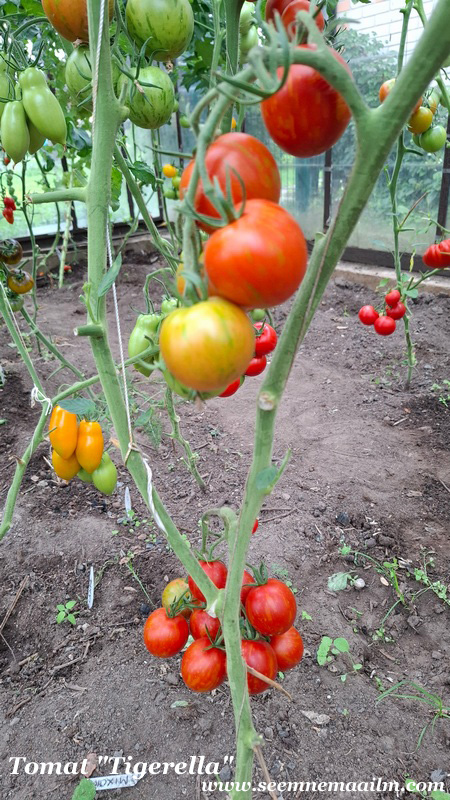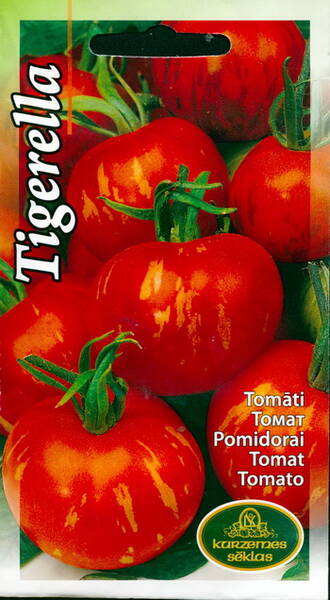Ex Tax: 1.35€
Mid-early, indeterminate variety. Plant height 2.0-2.3 m. Fruits weighing 100-130 g, striped, round.
They have excellent taste qualities. Recommended for fresh consumption and canning.

* Before sowing, seeds can be treated with a growth regulator: Epin (0.5 ml per 2 L of water) – increases germination energy and seedling emergence, enhances resistance to adverse environmental conditions. Seeds are soaked for 2 hours, using 20 ml per 10 g of seeds. Seeds are sown in special boxes 40–50 cm long, 30–35 cm wide, 8 cm high, filled with a turf-compost mixture.
For better initial seedling growth, the prepared mixture is supplemented with the following mineral fertilizers (1 g per 10 L of water): ammonium nitrate – 5–10; superphosphate – 40–50; potassium sulfate – 15–20, or nitroammophoska at 40–60 g per 10 L of water. Boxes are placed in a room, warm greenhouse, or cold frame.
Before sowing, moisten and level the soil. Transverse furrows 0.5–1 cm deep are made every 4–5 cm. Seeds are placed 1 cm apart. The less densely they are sown, the longer seedlings can be kept in the boxes without risk of stretching due to overcrowding.
After sowing, seeds are covered with a moist soil layer 1.5–2 cm thick. (Shallower coverage leads to rapid drying of the topsoil where seeds are located.) Boxes are covered with film to ensure uniform germination. However, in sunny days, the temperature under the film can rise to +30–40°C, which may kill the sprouts. Therefore, before emergence, boxes are additionally covered with opaque material or placed in the shade. If boxes are in darkness, remove the cover before seedlings emerge and place them in light. After cotyledons unfold, reduce the temperature to +13–16°C during the day and +11–13°C at night to prevent stretching.
After one week, increase it: in sunny days to +20–22°C, on cloudy days to +18–19°C, at night to +17–18°C.
Seedlings are moderately watered, preferably in sunny mornings. Excess air and soil moisture can cause “damping-off” disease.
Often, due to shallow sowing or poor seed quality, seed coats remain on the cotyledon tips, hindering seedling growth. To facilitate seed coat removal, spray seedlings several times with warm water at cotyledon unfolding. The seed coat softens and comes off easily.
Pricking out (transplanting) seedlings is necessary for the plant to receive enough soil volume and air for further growth. The earlier it is done (cotyledon stage), the better plants tolerate it.
However, young seedlings are fragile, and many may be damaged. The optimal time is when the first or second true leaf appears, usually 10–14 days after emergence.
Select healthy, well-developed seedlings for pricking. Moisten soil well the day before. Carefully lift seedlings, minimizing root damage. Transplant seedlings into peat-compost, paper, cardboard, polyethylene, or other pots 8–12 cm in diameter.
The potting mixture consists of 7 parts decomposed lowland peat, 2 parts compost, and 1 part turf. Alternatively, 3 parts sawdust, 1 part soil, and 2 parts peat. Water the mixture with a mineral fertilizer solution (1 g per 10 L of water): ammonium nitrate – 10, superphosphate – 50, potassium sulfate – 20, magnesium sulfate – 10.
Make a hole 5–6 cm deep in the soil and place the seedling by the cotyledons. Ensure the root does not bend upwards. Slightly compact the soil around the hypocotyl with fingers. Water transplanted seedlings with warm water and shade them for 1–2 days to promote rooting.
During seedling growth, monitor temperature and humidity. Soil and air temperature depends on lighting. Initially, in sunny days, air temperature should not exceed +20°C, and at night +17–18°C. After 4–5 leaves appear, reduce temperature to +18–20°C during the day and +14–15°C at night. On cloudy days, reduce daytime temperature by 2–3°C.
One to two weeks before planting, lower air temperature during the day to +17–18°C. Soil temperature should be at least +18–20°C. Water seedlings moderately in sunny mornings. Excess moisture causes elongated and fragile seedlings. Excess soil dryness negatively affects future productivity.
One week before planting, sharply reduce watering. Combined with lower temperatures, this hardens seedlings. If grown indoors, periodically moisten the air.
In greenhouses or frames without pre-applied fertilizers, seedlings are fertilized during growth: first 1–2 weeks after pricking, second 7–10 days before planting. Fertilizer composition (g per 10 L water): ammonium nitrate – 5–7, superphosphate – 30–40, potassium sulfate – 15–20. If unavailable, use nitroammophoska at 15–20 g per bucket. Fertilize in the morning, on sunny days. Apply solution at 10 L per 1–1.5 m². Immediately water after fertilization to wash residues from leaves.
If seedlings are grown under simple film covers or cold frames, cover them additionally at night.
To acclimate seedlings for harsher outdoor conditions, start from 25–30 days of age. If grown indoors, move them outside during the day. Gradually increase exposure. 3–4 days before planting, leave outdoors full-time.
In frames, harden seedlings by periodically removing the frames. Plant tomatoes no taller than 30–35 cm with stem diameter 0.8–1 cm. The plant should have 5–6 leaves (determinant varieties) or 7–9 leaves (indeterminate varieties) and flower buds on the first inflorescence.












